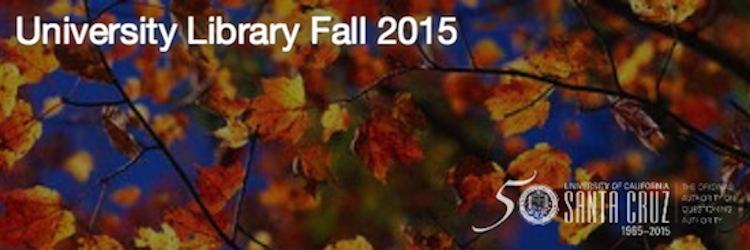
- From the University Librarian
- “You have to spread it around to make things grow”—Joop Rubens interviews Dave Kirk
- Grateful Dead Archive Contributes to Mammoth Boxed Set
- "Plant in a square but harvest in a circle": a conversation with the library's first Development Director, Margaret Gordon
- New Exhibit in Special Collections & Archives: “What is a Book?”
This is the time every year when we welcome back faculty and students to the campus. Even though we are still experiencing summertime temperatures, the quickened tempo across campus says fall is here—and, with it, another year of institutional aspiration and intellectual adventure.
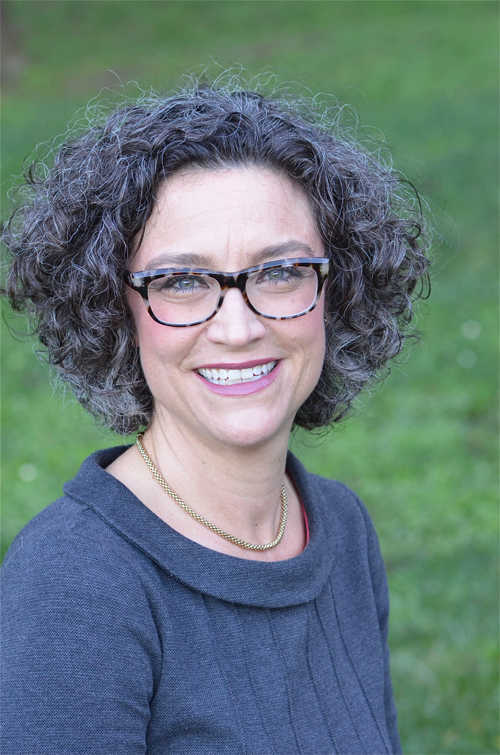 I’d like to report progress on something you heard about first in the Winter 2015 newsletter. You learned about how we are applying core librarian skills to managing information in formats other than print on paper. We are seeing faculty moving quickly into new forms of scholarship in the humanities and other fields. This has pushed us to explore how our core mission to collect, preserve, and provide access to information connects with our goal of facilitating scholarly communication in the digital environment. We are close to launching the Digital Scholarship Commons in McHenry Library to experiment with new ideas and meet a growing demand. In this space, all members of the campus community will have the opportunity to experiment with technology, consult with library experts, and collaborate on projects that highlight the role of the digital in today’s scholarship. Thanks to the outstanding leadership of our postdoctoral fellow Rachel Deblinger, we are building a community across campus of stakeholders interested in this work. We are collaborating with a variety of centers and services on campus to make sure scholars are aware of what is available to them as they plan their work. Our goals are to increase student access to new technology, improve the success of scholars seeking grant funding, and create a strong dialogue on campus about digital scholarship.
I’d like to report progress on something you heard about first in the Winter 2015 newsletter. You learned about how we are applying core librarian skills to managing information in formats other than print on paper. We are seeing faculty moving quickly into new forms of scholarship in the humanities and other fields. This has pushed us to explore how our core mission to collect, preserve, and provide access to information connects with our goal of facilitating scholarly communication in the digital environment. We are close to launching the Digital Scholarship Commons in McHenry Library to experiment with new ideas and meet a growing demand. In this space, all members of the campus community will have the opportunity to experiment with technology, consult with library experts, and collaborate on projects that highlight the role of the digital in today’s scholarship. Thanks to the outstanding leadership of our postdoctoral fellow Rachel Deblinger, we are building a community across campus of stakeholders interested in this work. We are collaborating with a variety of centers and services on campus to make sure scholars are aware of what is available to them as they plan their work. Our goals are to increase student access to new technology, improve the success of scholars seeking grant funding, and create a strong dialogue on campus about digital scholarship.
The Digital Scholarship Commons will be located in the David P. Kirk Media Center in McHenry Library. More information can be found here: https://library.ucsc.edu/digitalscholarship/digital-scholarship-commons.
We plan to open with an event in January. I hope to see many of you there!
Elizabeth Cowell
Richard L. Press University Librarian
Presidential Chair
“You have to spread it around to make things grow”—Joop Rubens interviews Dave Kirk
The David P. Kirk Media Center will soon host our Digital Scholarship Commons program. So I wanted to dig up some of the history behind the Library’s media center. Although Dave Kirk, the space’s namesake, retired in 2002, he remains a strong supporter of the campus. And so between his globetrotting adventures and his time devoted to taking award-winning photographs, we met up for a cup of coffee.
JR: How did you get started working for the Library?
DK: I began working for UC Santa Cruz in 1972, and continued to do so for thirty years before retiring in 2002. Although I started off in Media Services, when the University Library needed someone to maintain the growing media archive and publish their film catalogues, I jumped at 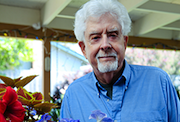 the opportunity. My skills and knowledge were a great fit. And as a passionate “cinephile,” I was excited about the prospect of building an impressive film archive in support of faculty and students. Ever since I was a child, I was a library person—an avid reader. Books have always been a special part of my life. And since I am also an absolute “movie nut,” getting a job with the University Library to develop the media collection was a dream come true for me. Once I had my library degree, I became the Media Specialist on campus and during my career managed the language lab and for five years also managed the Media Center.
the opportunity. My skills and knowledge were a great fit. And as a passionate “cinephile,” I was excited about the prospect of building an impressive film archive in support of faculty and students. Ever since I was a child, I was a library person—an avid reader. Books have always been a special part of my life. And since I am also an absolute “movie nut,” getting a job with the University Library to develop the media collection was a dream come true for me. Once I had my library degree, I became the Media Specialist on campus and during my career managed the language lab and for five years also managed the Media Center.
JR: What are some of your best memories of your work as a Media Specialist for the Library?
DK: Working with the faculty was the best. It was my mission to find materials they wanted to use in support of their teaching. And I strived to anticipate their needs. It meant that I needed to closely track anything that came out on film, but I loved doing that. I remember when Professor Michael Warren, our resident Shakespeare expert at the time, phoned me one day, excited because he had just found out that there was a new Shakespeare play on video. I proudly replied, “Yes I know. I just bought it last week. You’ll be able to use it in your classes very soon.” Working with the faculty in their various divisions, departments, and subject fields, UCSC was able to build the third-largest media archive in the UC system, with unique collections in many subject fields.
Another wonderful moment was when a personal friend of twenty-five years, Mary Thush, really stepped up to help the campus. I had previously started a small endowment on campus aimed to preserve and further build our media collection. When I asked her if she would be interested in supporting the endowment she replied: “What if I give you my entire estate?” I was blown away. People had to pick me off the floor. A few weeks later she re-wrote her will and gave her estate to the UCSC Library in honor of me. After her death the money was used in support of the Media Center, and the space was ultimately named after me. These funds allowed the newly named David P. Kirk Media Center to become what I always wanted it to be. We were in need of equipment: computers, monitors, video players (VHS, Laserdisc, DVD), etc. We now have a number of group viewing rooms available to faculty and students, equipped with a variety of audiovisual equipment where students can meet, view, and study. Her gift is one that will keep on giving.
JR: How do you feel about the David P. Kirk Media Center hosting the Digital Scholarship Commons?
DK: The Library is really the knowledge hub on campus. People tend to question the relevance of libraries in the digital age, but that contradicts the fact that we are seeing a rise in the overall number of library patrons. And that’s true for the David Kirk Media Room as well. I know things are evolving and technology is changing. So to have this space host an innovative program such as the Digital Scholarship Commons is encouraging. I hope it will further drive up the use of the room, and we will need to monitor that. But I envision that this program will bring a lot of events and research to the Media Center and provide a venue where cutting-edge interactive learning is the norm.
JR: Why do you continue to support the University?
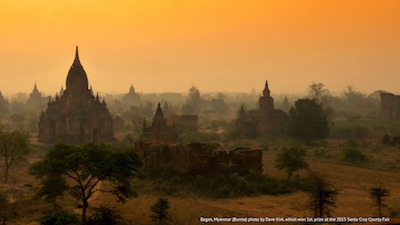 DK: A university is an engine for change. Beneficial change. Change that produces results and has meaning. As for the money it takes to actualize that change, I like to quote a scene from The Matchmaker, the Thornton Wilder play that was turned into the Broadway musical Hello, Dolly! At one point in the play, Dolly Levi, the main character, says: “My late husband Ephraim always said, ‘Money is like manure—you have to spread it around to make things grow.’” I hope these new developments with the Digital Scholarship Commons will fulfill this promise of growth.
DK: A university is an engine for change. Beneficial change. Change that produces results and has meaning. As for the money it takes to actualize that change, I like to quote a scene from The Matchmaker, the Thornton Wilder play that was turned into the Broadway musical Hello, Dolly! At one point in the play, Dolly Levi, the main character, says: “My late husband Ephraim always said, ‘Money is like manure—you have to spread it around to make things grow.’” I hope these new developments with the Digital Scholarship Commons will fulfill this promise of growth.
And don’t forget, contributions to the Media Center Endowment are still welcome!
Grateful Dead Archive Contributes to Mammoth Boxed Set
Nicholas G. Meriwether, Grateful Dead Archivist
The remaining members of the Grateful Dead have been in the news a great deal this year, the fiftieth anniversary of their founding, with their farewell shows this past summer generating particularly extensive media coverage. For those mystified by the attention, what underlies the accolades is a significant accomplishment: more than 2,300 concerts performed over thirty years, to an audience reckoned by some to be 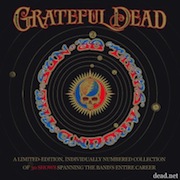 the largest of any rock band. They never played the same show twice, varying their set lists and interpretations in a way that made them irresistible to fans of improvisatory music. Best of all, the band recorded its concerts, and over the years fans have enjoyed more than two hundred releases from those tapes, now stewarded by Vault Archivist David Lemieux.
the largest of any rock band. They never played the same show twice, varying their set lists and interpretations in a way that made them irresistible to fans of improvisatory music. Best of all, the band recorded its concerts, and over the years fans have enjoyed more than two hundred releases from those tapes, now stewarded by Vault Archivist David Lemieux.
Much of the band’s storied history is documented in the voluminous archive that the Dead donated to the University Library in 2008, which is why the Grateful Dead Archive continues to play a vital role in the ongoing historical releases that the band publishes with Rhino Records every year. After David Lemieux selects the performance, I go to work scouring the band’s archive for supporting materials: photographs, press clippings, contracts, tickets, backstage passes—anything that might add a touch of historicity and context to the music being showcased. To date, the Archive has provided hundreds of images for dozens of releases, spanning four boxed sets and nearly two dozen other CD sets.
By far the biggest effort the Archive and the Dead have collaborated on is the band’s career-long retrospective, 30 Trips Around the Sun, scheduled for release in October. Featuring thirty performances from 1965 to 1995, one from every year the band performed, the boxed set is one of the largest and most ambitious releases in rock music history, with eighty CDs and a 288-page book. It features nearly a hundred illustrations drawn from a wide range of the Archive’s resources, including contracts, posters, photographs, tickets, backstage passes, press clippings, and correspondence. Supplying research and images for this effort was more than just an obligation that the Library assumed when it accepted the Archive: it was also a pleasure, the fulfillment of the Archive’s pledge to share its treasures widely.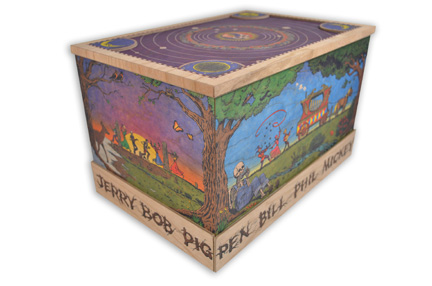
A wealth of details drawn from the Archive also inform the liner notes for the boxed set, making the release an example of the extraordinary possibilities that close collaboration between academic archives and donors can create. As archives work to expose their holdings to wider constituencies, the ongoing relationship between the Grateful Dead, Rhino Records, and the Archive represents a powerful example of how archival holdings can enrich a wide audience.
How did you end up at UC Santa Cruz?
I moved here after graduating from Radcliffe. My husband got a job teaching at UC Santa Cruz and I had planned to go to UC Berkeley and pursue a PhD in English literature. I ended up being hired by UC Santa Cruz in 1970 to lead the Library’s “Order Search.” Back in the day 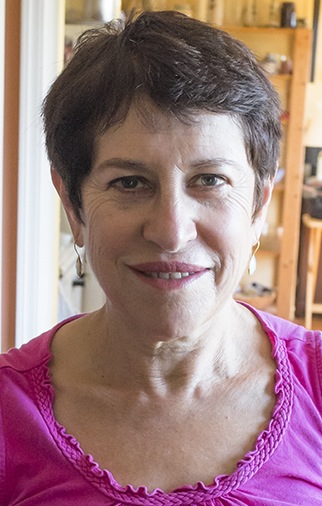 faculty would come to us to place book orders. Maybe they were looking for a certain topic or particular research, and since we did not have the online resources we have now, someone had to make sure these requested books were available. We needed to find the printed source and find the lowest-price seller. My knowledge of literature and the book trade, as well as being a pretty organized person, made this a wonderful job for me.
faculty would come to us to place book orders. Maybe they were looking for a certain topic or particular research, and since we did not have the online resources we have now, someone had to make sure these requested books were available. We needed to find the printed source and find the lowest-price seller. My knowledge of literature and the book trade, as well as being a pretty organized person, made this a wonderful job for me.
I loved this work and loved working for the faculty in our Library. So I ended up going to library school. Although I had a full scholarship to attend UC Berkeley, driving to the East Bay would take me away from my home too much, and so I ended up going to San Jose State instead. One and a half years later I was officially a librarian. With my library degree I was able to become the Head of Reference for the UCSC Library. Within a few years I became part of the Library’s senior management team.
In the early 1990’s our Library was starting to feel pressure to gain more independence from state funding. We realized we had to raise private money, because state funding would eventually not be able to carry all of our needs. The University Librarian at the time, Lan Dyson, understood the power of our existing volunteer network. A few years earlier we had started the “Friends of the UCSC Library.” This group of volunteers initially did not raise money, but instead existed to help decide how to spend membership dues. It became my mission to transform the “Friends of the UCSC Library” into a skillful fundraising board. We started by offering donors a $10,000 “Library Subject Endowment” to fund acquisitions in the donor’s choice of field. At the time this was a big culture shift. We were unsure if this would work. I remember calling my mom and asking her for a gift. Well, our plans started to take shape and I loved working as a fundraiser.
What did you love about fundraising?
You are immediately engaged in a non-trivial conversation with people. You are addressing topics such as love, legacy, values, and passion. If you can help someone identify what is truly important to them and reflect that back to them, that’s a wonderful experience. Of course there are a million worthy causes, and it is tough to compete with organizations that raise support to help fill very concrete gaps in poverty stricken areas. But all people look for meaning and impact in various ways, and if you are able to provide this meaning to them, they get engaged, they may support the cause, and they may even continue to give over many years.
This ongoing support is very important to any program. You see, some people have the capacity to give large transformative sums of money, but even when people are unable to give much, their loyal commitment over many years can add up to tremendous support.
How did you increase the number of supporters for the Library?
In a library, collections or facilities are always a priority to donors. But of course books are important as well, especially back then before Kindles, iPads, and the rest. In order to fund a growing book collection, I started our “Buy a Book” program. And although the Library was not perceived as a place that would easily raise money, I was blessed to have the assistance of founding Chancellor Dean McHenry who still had an office in our McHenry Library. He was an incredible person and always had the welfare of the campus as his priority. He decided he would help me and sign letters to all of our pioneer alumni asking them to help us start this “Buy a Book” program. This led to our Library Subject Endowments, a program where people could focus their giving for a period of time, choose a particular subject they wanted to support, and so on. We would send them the list of books they helped us acquire. The program proved to be very popular. At some point we raised a total of $2 million in Subject Endowments.
But again, it was the relationship over time that made all the difference. One of our supporters for instance, the Graydon family, made their first “Buy a Book” gift at $300. I had never met them. But when work brought Mike out to California I was able to build a stronger relationship and fully understand what their philanthropic wishes were. And so their gifts to the library increased year after year.
These relationships I built with our supporters are some of the most important relationships I have in my life. When 9/11 happened, Mike Graydon lived in downtown Manhattan, as did my family. That day I called my family, and the second person I called was Mike.
There are so many other examples. When I became acquainted with the Ackerknechts, Bill’s first wife Mary was very ill. They were “Friends of the Library.” Mary’s health issues prevented her from coming to the Library. So for years, I would check out books for her and bring her what she wanted to read. When Mary passed, Bill funded the McHenry lawn area for $100,000 in her honor. He added another reading garden to his gift and named it after me.
What would be your advice to a fundraiser?
We built our program slowly and in partnership with our supporters. It often took over ten years for people to move from a $300 gift, to a donor who would eventually give a transformative gift. University Relations at the time was led by Dan Aldridge and Nancy Loskajian. They understood that our approach was working. As Nancy once told me, “Numeric goals are not a stick to beat you up with, they are a tool to keep you on track.” Their leadership allowed us to focus on the relationships and led to our fundraising success.
Fundraising is “Never a linear process.” Anything that seems too formulaic is the death of fundraising. The key is to understand the riches that are present at the library—not just the collections and the facilities, but also the staff. There are incredible people on staff and their knowledge and expertise mean a lot to our supporters.
I also was a donor myself. If we give to the to extent that it is somewhat of a financial sacrifice, then we understand our donors. The Library Subject Endowment I started has grown to about $100,000.
But in the end you have to really love your donors. You’re working for them. The people I worked for were generous and they took risks. But they are all incredible people. Working at a university for forty years has the potential to be insular. But I got to experience the real world, with people who are very different from me, but people who were engaging with something they loved.
Do you miss fundraising?
I retired from UC Santa Cruz as I was having some severe vision issues. Our McHenry capital campaign had wrapped up and it seemed like the right time to retire. But do I miss fundraising? No, I don’t miss it. I don’t have to, because I do it every day of my life. You see, nobody likes an ancient librarian, but everyone likes an old fundraiser. As fundraisers we know people, and we spent years building a network and strong relationships. So I am on the board of Hospice and CASA, and I help to raise money for our temple. In fact, this past week we just raised $100,000 for CASA.
“It is our duty to give back. We need to plant in a square but harvest the circle, leaving the corners of the field to the people less fortunate.”
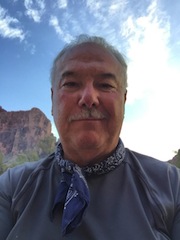 "My freshman year would have been my last at UCSC without the help given me by McHenry librarians. That Margaret Gordon too, is an excellent practitioner of library science is indisputable. More important is her empathy with prospective and long term donors. She offers deft guidance in making a library gift as meaningful to the donor as it is to the McHenry Library."
"My freshman year would have been my last at UCSC without the help given me by McHenry librarians. That Margaret Gordon too, is an excellent practitioner of library science is indisputable. More important is her empathy with prospective and long term donors. She offers deft guidance in making a library gift as meaningful to the donor as it is to the McHenry Library."
~Michael Graydon, (Cowell '70)
New Exhibit in Special Collections & Archives: “What is a Book?”
Artists’ books are one of the great strengths of UCSC’s Special Collections. Our newest exhibit features a large selection of formats and themes and explores the question “What is a book?” There is no one definition for the term “artists’ books,” but Stephen Bury says it well: “Books or book-like objects over the final appearance of which an artist has had a high degree of control; where the book is intended as a work of art in itself.”
UCSC’s stunning collection of artists’ books has grown over the past 50 years thanks to the attention of Special Collections staff and thanks to the generosity of the Friends of the Library and individual donors. These treasures deserve a chance to come out of the closed stacks and bask in the limelight and in the delight of the public.
Please join us for the official opening of this exhibit on Thursday, December 3, at 4:00. In the meantime, feel free to drop by Special Collections for an informal preview
Contributors: Elizabeth Cowell, Joop Rubens, Nicholas G. Meriwether and Beth Remak-Honnef
Production: Linda Hunt
Copyediting: Mark Engel
Photography: Joop Rubens, Beth Remak-Honnef. Linda Hunt, Dave Kirk and Michael Graydon


 Santa Cruz, CA
Santa Cruz, CA



